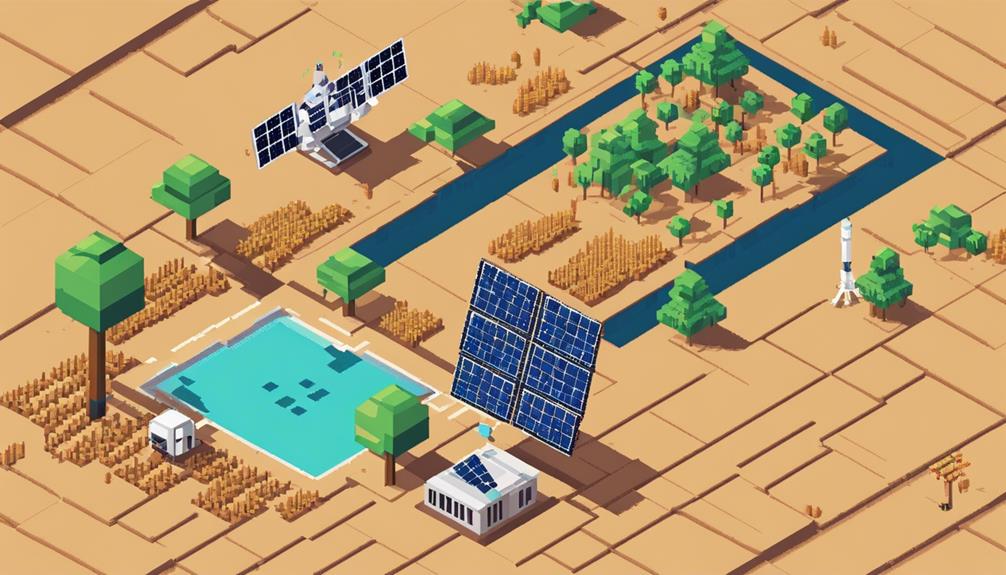The intersection of satellite benefits and environmental concerns presents a complex landscape demanding thoughtful consideration. As the reliance on satellite technologies grows for communication, navigation, and Earth observation, the environmental implications become increasingly apparent. Balancing the advantages of global connectivity with the potential adverse impacts on Earth's ecosystems requires a nuanced approach. Exploring how innovative solutions can address these challenges while fostering sustainable practices is essential for shaping a future where satellite technology can thrive in harmony with the environment.
Key Takeaways
- Sustainable satellite design minimizes environmental impact.
- Responsible disposal practices are crucial for long-term sustainability.
- Mitigating space debris and light pollution is essential.
- Regulatory standards and global collaboration are key for balancing benefits and concerns.
Satellite Benefits for Society and Environment

Satellite technology plays a pivotal role in facilitating global communication, navigation, and environmental monitoring. Satellites provide crucial data for climate change assessment and disaster response. The utilization of satellite data is instrumental in understanding the environmental impact of human activities and plays a significant role in promoting sustainable practices. Satellites offer global coverage, enabling the collection of data from remote regions that are otherwise challenging to access. This comprehensive coverage allows for a holistic view of environmental changes, aiding in the monitoring and mitigation of climate change effects.
The integration of satellite technology in environmental monitoring has revolutionized the way we assess and respond to environmental challenges. By providing real-time data on environmental parameters such as temperature, vegetation cover, and sea level changes, satellites empower decision-makers to implement effective strategies for environmental conservation. Moreover, satellite imagery with high resolution supports detailed land use and biodiversity assessments, facilitating informed decision-making processes.
In the context of climate change, satellite data plays a crucial role in monitoring trends, identifying vulnerable regions, and evaluating the effectiveness of mitigation efforts. This information is invaluable for policymakers and researchers working towards sustainable practices and climate resilience. By leveraging satellite technology, we can enhance our understanding of environmental dynamics and work towards a more sustainable future.
Positive Impacts on Connectivity and Research
Satellite technology plays a crucial role in improving global connectivity by expanding internet access to underserved areas and enhancing data collection capabilities for researchers. This advancement leads to a significant boost in scientific discoveries and innovations by providing valuable insights into environmental changes and natural phenomena. By facilitating seamless communication and data exchange, satellites contribute to the advancement of knowledge and the development of sustainable solutions for pressing global challenges.
Improved Internet Access
How does the advancement of internet access through modern satellite technology contribute to the enhancement of connectivity and research capabilities in remote and underserved regions? Satellite internet services play a crucial role in providing internet access to people in rural and remote areas where traditional broadband services are limited. This improved connectivity enables individuals and communities to access a wealth of online resources, including educational materials and research databases, fostering learning and innovation. Moreover, satellite technology facilitates real-time communication and collaboration, essential for remote research projects and data sharing. By empowering underserved regions with reliable internet access, satellite services not only bridge the digital divide but also stimulate socio-economic development by opening doors to e-commerce opportunities and global partnerships in research and knowledge exchange.
Enhanced Data Collection
With the proliferation of advanced satellite technology, the realm of data collection has experienced significant enhancements, particularly in the realms of connectivity and research in remote and underserved regions.
Key Impacts of Enhanced Data Collection:
- Improved Connectivity: Satellite data enables enhanced internet access and communication in remote areas.
- Research Advancements: Satellite technology supports environmental monitoring, precision agriculture, and disaster response research.
- Remote Sensing Applications: Satellite data aids in tracking deforestation, biodiversity conservation, and land use changes for better resource management.
These advancements showcase the critical role satellite technology plays in enhancing data collection for various crucial purposes, ranging from environmental monitoring to disaster response and beyond.
Boosting Scientific Discoveries
In the realm of scientific exploration and research, the integration of advanced satellite technology has significantly bolstered connectivity and enhanced the scope of innovative discoveries. Satellite data plays a pivotal role in boosting scientific discoveries by providing researchers with real-time information from remote areas, fostering global collaboration among scientists, and enabling breakthrough research. Furthermore, satellite technology is instrumental in environmental monitoring, offering valuable insights into climate change, ecosystem dynamics, and the tracking of natural disasters. The utilization of remote sensing data obtained through satellites not only aids in environmental studies but also accelerates research in diverse fields such as astronomy, geology, meteorology, and oceanography. Overall, satellites are indispensable tools that drive scientific progress and enable groundbreaking discoveries across various disciplines.
Challenges in Satellite Environmental Impact
The challenges in satellite environmental impact encompass a range of concerns, from the emissions produced by rocket launches to the risks posed by space debris. These issues extend to the disruption of wildlife habitats caused by light pollution from satellite constellations. Addressing these challenges requires comprehensive strategies to mitigate environmental harm and sustainably manage satellite activities in space.
Emissions From Satellites
Satellite emissions pose significant challenges in terms of their environmental impact, contributing to air pollution and greenhouse gas emissions throughout their lifecycle.
Key Points:
- Air Pollution: Satellite emissions during launches and operations contribute to air pollution, impacting the environment.
- Greenhouse Gas Emissions: The manufacturing and operation of satellites generate greenhouse gas emissions, adding to the environmental footprint.
- Environmental Impact: Satellite propulsion systems release exhaust gases that can have both localized and global environmental consequences, highlighting the need for responsible satellite disposal practices to reduce the carbon footprint of satellites. Monitoring and reducing satellite emissions are crucial steps in addressing environmental concerns.
Space Debris Concerns
Amid the rapid expansion of satellite technology, the growing concern over space debris underscores the critical need for effective management strategies to safeguard orbital environments. Satellite collisions pose significant risks, potentially creating debris fields that endanger other satellites and space infrastructure like the International Space Station. Responsible disposal practices are essential for ensuring long-term sustainability in space operations. With the increasing number of satellite launches, the risks of collisions and space debris creation are on the rise, necessitating proactive measures to address these environmental concerns. Satellite operators must prioritize managing space debris to mitigate the potential threats posed by defunct satellites and space debris accumulation, emphasizing the importance of responsible practices for the sustainability of space activities.
Wildlife Disruption Impacts
Given the expanding footprint of satellite technology and its implications on the environment, an emerging concern lies in the disruption of wildlife and ecosystems caused by satellite operations.
Key Points:
- Satellite operations can disrupt wildlife behavior and ecosystems through habitat disturbance.
- Artificial light from satellites can affect nocturnal animals' natural behaviors and migration patterns.
- Wildlife populations near ground infrastructure sites may experience displacement or changes in behavior.
Efforts to mitigate wildlife disruption from satellite operations include strategic site selection and ongoing monitoring. The impact of satellite technology on wildlife varies depending on deployment location and scale. Enhancing our understanding of these impacts is crucial for balancing satellite benefits with environmental conservation efforts.
Space Debris and Orbital Congestion Concerns
The proliferation of space debris presents a pressing challenge to the sustainability and safety of activities conducted in Earth's orbit. Space debris, composed of defunct satellites and various fragments, poses significant risks of collision and contributes to orbital congestion. As the number of satellite launches continues to rise, the issue of orbital debris becomes more prominent, threatening active satellites and space missions.
To address these challenges, implementing responsible disposal practices is crucial. Properly disposing of defunct satellites and spacecraft at the end of their mission lifecycles can help mitigate the risks of space debris accumulation. International guidelines have been established to govern space debris management and promote sustainable space activities. These guidelines aim to regulate the disposal of satellites, encourage the development of debris mitigation strategies, and foster international cooperation in ensuring the long-term sustainability of space operations.
Energy Consumption and Light Pollution Issues

Satellite internet operations pose a significant energy consumption challenge, impacting the environment and contributing to carbon emissions. This issue is exacerbated by the growing number of satellites in orbit and the energy-intensive processes required to operate them efficiently.
Key Points:
- Renewable Energy Sources: Transitioning to renewable energy sources such as solar and wind can help reduce the carbon footprint of satellite services. By harnessing clean energy, satellite operators can minimize their environmental impact and contribute to a more sustainable future.
- Light Pollution from Satellite Constellations: Bright satellite constellations contribute to light pollution, disrupting ecosystems and hindering astronomical observations. To address this issue, satellite providers need to develop technologies that reduce the visibility of satellites from Earth, thus mitigating light pollution concerns.
- Preserving Natural Night Skies: Minimizing light pollution from satellites is essential to preserve the natural night skies and protect wildlife. By implementing strategies to reduce the brightness of satellites and control their orbital configurations, the adverse effects of light pollution can be mitigated, ensuring the conservation of our nightscapes for future generations.
Efforts to balance the benefits of satellite technology with environmental considerations are crucial for sustainable development in the space industry. By prioritizing energy efficiency and addressing light pollution concerns, satellite operators can minimize their ecological footprint and contribute to a more environmentally conscious approach to space exploration.
Sustainable Practices in Satellite Design
Efforts in the realm of satellite design are increasingly focused on implementing sustainable practices to minimize environmental impact across the satellite lifecycle. Sustainable satellite design encompasses various key aspects such as energy efficiency, materials selection, and end-of-life disposal strategies. Designers are strategically choosing materials that reduce resource consumption and emissions while ensuring the satellite's functionality and durability. Energy efficiency is a critical consideration in satellite design to minimize the environmental impact associated with satellite operations. By optimizing power usage and adopting energy-efficient components, satellites can operate effectively while reducing their carbon footprint.
End-of-life disposal is another crucial factor in sustainable satellite design. Designers are exploring ways to ensure that satellites can be safely decommissioned at the end of their operational life without contributing to space debris or environmental pollution. Additionally, mitigating light pollution in space is a growing concern driving sustainable design practices. Satellites are being designed with features to minimize their contribution to light pollution and preserve the darkness of the night sky.
Mitigation Strategies for Environmental Concerns

With increasing emphasis on environmental sustainability, the aerospace industry is actively exploring mitigation strategies to address the ecological impact of satellite operations. To ensure a more environmentally conscious approach, several key strategies are being considered:
- Implementing Responsible Disposal Practices: Proper disposal of satellites at the end of their operational life is crucial for long-term sustainability. Implementing protocols for responsible disposal can help mitigate the accumulation of space debris in orbit, reducing the risk of collisions and space contamination.
- Developing Active Debris Removal Technologies: The development of active debris removal technologies is essential to reduce the amount of space debris in orbit. By actively removing defunct satellites and other debris, the risk of collisions and the generation of additional debris can be minimized, contributing to a cleaner space environment.
- Adhering to International Regulations: International guidelines and regulations play a vital role in addressing the issue of space debris and promoting responsible space activities. By complying with these regulations, satellite operators can contribute to a more sustainable use of space resources, ensuring the protection of satellite data, minimizing light pollution, and transitioning towards renewable energy sources for satellite operations.
Finding Balance: Society Vs. Environment
In light of the dual implications arising from the utilization of satellite technology, the imperative to balance societal benefits with environmental considerations has become a focal point of discussion within the aerospace industry. Satellite technology plays a crucial role in society by facilitating communication, enabling precise navigation systems, and aiding in environmental monitoring through satellite data. However, the environmental impact of satellite operations, such as resource utilization, atmospheric effects, and the generation of space debris, raises concerns among environmental organizations.
To address these challenges, it is essential to implement sustainable practices and promote responsible space activities. This involves developing strategies to minimize resource consumption, mitigate atmospheric impacts, and actively manage space debris to ensure the long-term sustainability of satellite operations. Finding a balance between societal needs, such as internet connectivity and data transmission, and environmental protection requires collaborative efforts among stakeholders, including aerospace companies, regulatory bodies, and environmental organizations.
Future of Satellite Technology and Sustainability

How can the advancements in satellite technology be steered towards a sustainable future that mitigates environmental impacts such as space debris and light pollution?
3 Key Considerations for the Future of Satellite Technology and Sustainability:
- Sustainable Practices: Implementing sustainable practices in satellite production and operation is essential to reduce environmental impacts. This includes using eco-friendly materials, designing satellites for longevity and recyclability, and adopting energy-efficient propulsion systems.
- Regulatory Standards: Collaboration among stakeholders is crucial to establish regulatory standards for managing space debris and controlling light pollution. Clear guidelines on satellite deployment, end-of-life disposal, and orbital trajectories can help mitigate environmental risks.
- Balancing Connectivity Needs: While meeting global connectivity needs is vital, it must be balanced with environmental sustainability. Initiatives like OneWeb and Project Kuiper are striving to expand broadband coverage worldwide while addressing concerns related to space debris and light pollution.
Frequently Asked Questions
How Does Satellite Affect the Environment?
Satellites impact the environment through emissions, energy consumption, habitat disruption, light pollution, and space debris. For instance, the satellite industry emits over 16 million tons of CO2 annually. Space debris from satellite collisions poses risks to operational satellites and spacecraft. Additionally, bright satellite constellations can disrupt nocturnal ecosystems. These environmental impacts highlight the need for sustainable practices in satellite operations to mitigate their adverse effects on Earth and space.
How Does Satellite Image Monitoring Help the Environment?
Satellite image monitoring is instrumental in enhancing ecosystem monitoring and aiding biodiversity preservation. It facilitates the detection of deforestation, leading to effective land conservation measures. Furthermore, satellite data enables tracking pollution, supporting resource management efforts. The technology plays a crucial role in monitoring water quality and ocean health. Additionally, it contributes to urban planning and efficient disaster response, while also improving agriculture efficiency through crop monitoring.
How Can Satellites Help With Climate Change?
Satellites play a pivotal role in addressing climate change through various means. They facilitate renewable energy development by assessing suitable locations for solar and wind farms. Satellite data aids in monitoring carbon footprints by tracking emissions from various sources globally. Remote sensing capabilities enable precise data analysis for climate research, weather forecasting, and deforestation monitoring. These tools empower policymakers and scientists to make informed decisions and implement effective climate change mitigation strategies.
What Is the Role of Satellites in Environment Protection and Management?
Satellites play a vital role in environment protection and management through various functions like satellite mapping, ocean monitoring, deforestation tracking, pollution detection, wildlife conservation, and agricultural monitoring. They provide critical data for assessing environmental changes, enabling informed decision-making for policymakers and researchers. Satellite technology enhances our ability to monitor and address environmental issues, contributing to better environmental protection and management strategies.

